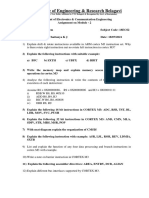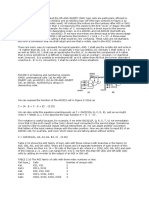Floor Placements
Uploaded by
venkateshFloor Placements
Uploaded by
venkatesh16.
2 Placement
After completing a floorplan we can begin placement of the logic cells within
the flexible blocks. Placement is much more suited to automation than
floorplanning. Thus we shall need measurement techniques and algorithms.
After we complete floorplanning and placement, we can predict both intrablock
and interblock capacitances. This allows us to return to logic synthesis with
more accurate estimates of the capacitive loads that each logic cell must drive.
16.2.1 Placement Terms and Definitions
CBIC, MGA, and FPGA architectures all have rows of logic cells separated by
the interconnect—these are row-based ASICs . Figure 16.18 shows an
example of the interconnect structure for a CBIC. Interconnect runs in
horizontal and vertical directions in the channels and in the vertical direction
by crossing through the logic cells.Figure 16.18 (c) illustrates the fact that it is
possible to use over-the-cell routing ( OTC routing) in areas that are not
blocked. However, OTC routing is complicated by the fact that the logic cells
themselves may contain metal on the routing layers. We shall return to this
topic in Section 17.2.7, “Multilevel Routing.” Figure 16.19 shows the
interconnect structure of a two-level metal MGA.
FIGURE 16.18 Interconnect structure. (a) The two-level
metal CBIC floorplan shown in Figure 16.11 b. (b) A channel
from the flexible block A. This channel has a channel height
equal to the maximum channel density of 7 (there is room
for seven interconnects to run horizontally in m1). (c) A
channel that uses OTC (over-the-cell) routing in m2.
Most ASICs currently use two or three levels of metal for signal routing.
With two layers of metal, we route within the rectangular channels using the
first metal layer for horizontal routing, parallel to the channel spine, and the
second metal layer for the vertical direction (if there is a third metal layer it
will normally run in the horizontal direction again). The maximum number of
horizontal interconnects that can be placed side by side, parallel to the channel
spine, is the channel capacity .
FIGURE 16.19 Gate-array interconnect. (a) A small two-
level metal gate array (about 4.6 k-gate). (b) Routing in a
block. (c) Channel routing showing channel density and
channel capacity. The channel height on a gate array may
only be increased in increments of a row. If the interconnect
does not use up all of the channel, the rest of the space is
wasted. The interconnect in the channel runs in m1 in the
horizontal direction with m2 in the vertical direction.
Vertical interconnect uses feedthroughs (or feedthrus in the United States)
to cross the logic cells. Here are some commonly used terms with explanations
(there are no generally accepted definitions):
An unused vertical track (or just track ) in a logic cell is called
an uncommitted feedthrough (also built-in feedthrough , implicit
feedthrough , or jumper ).
A vertical strip of metal that runs from the top to bottom of a cell
(for double-entry cells ), but has no connections inside the cell, is also
called a feedthrough or jumper.
Two connectors for the same physical net are electrically equivalent
connectors (or equipotential connectors ). For double-entry cells these
are usually at the top and bottom of the logic cell.
A dedicated feedthrough cell (or crosser cell ) is an empty cell (with no
logic) that can hold one or more vertical interconnects. These are used if
there are no other feedthroughs available.
A feedthrough pin or feedthrough terminal is an input or output that
has connections at both the top and bottom of the standard cell.
A spacer cell (usually the same as a feedthrough cell) is used to fill space
in rows so that the ends of all rows in a flexible block may be aligned to
connect to power buses, for example.
There is no standard terminology for connectors and the terms can be very
confusing. There is a difference between connectors that are joined inside the
logic cell using a high-resistance material such as polysilicon and connectors
that are joined by low-resistance metal. The high-resistance kind are really two
separate alternative connectors (that cannot be used as a feedthrough),
whereas the low-resistance kind are electrically equivalent connectors. There
may be two or more connectors to a logic cell, which are not joined inside the
cell, and which must be joined by the router ( must-join connectors ).
There are also logically equivalent connectors (or functionally equivalent
connectors, sometimes also called just equivalent connectors—which is very
confusing). The two inputs of a two-input NAND gate may be logically
equivalent connectors. The placement tool can swap these without altering the
logic (but the two inputs may have different delay properties, so it is not
always a good idea to swap them). There can also be logically equivalent
connector groups . For example, in an OAI22 (OR-AND-INVERT) gate there
are four inputs: A1, A2 are inputs to one OR gate (gate A), and B1, B2 are
inputs to the second OR gate (gate B). Then group A = (A1, A2) is logically
equivalent to group B = (B1, B2)—if we swap one input (A1 or A2) from gate
A to gate B, we must swap the other input in the group (A2 or A1).
In the case of channeled gate arrays and FPGAs, the horizontal interconnect
areas—the channels, usually on m1—have a fixed capacity (sometimes they
are calledfixed-resource ASICs for this reason). The channel capacity of
CBICs and channelless MGAs can be expanded to hold as many interconnects
as are needed. Normally we choose, as an objective, to minimize the number of
interconnects that use each channel. In the vertical interconnect direction,
usually m2, FPGAs still have fixed resources. In contrast the placement tool
can always add vertical feedthroughs to a channeled MGA, channelless MGA,
or CBIC. These problems become less important as we move to three and more
levels of interconnect.
16.2.2 Placement Goals and Objectives
The goal of a placement tool is to arrange all the logic cells within the flexible
blocks on a chip. Ideally, the objectives of the placement step are to
Guarantee the router can complete the routing step
Minimize all the critical net delays
Make the chip as dense as possible
We may also have the following additional objectives:
Minimize power dissipation
Minimize cross talk between signals
Objectives such as these are difficult to define in a way that can be solved
with an algorithm and even harder to actually meet. Current placement tools
use more specific and achievable criteria. The most commonly used placement
objectives are one or more of the following:
Minimize the total estimated interconnect length
Meet the timing requirements for critical nets
Minimize the interconnect congestion
Each of these objectives in some way represents a compromise.
16.2.3 Measurement of Placement Goals and
Objectives
In order to determine the quality of a placement, we need to be able to measure
it. We need an approximate measure of interconnect length, closely correlated
with the final interconnect length, that is easy to calculate.
The graph structures that correspond to making all the connections for a net
are known as trees on graphs (or just trees ). Special classes of trees
— Steiner trees —minimize the total length of interconnect and they are
central to ASIC routing algorithms. Figure 16.20 shows a minimum Steiner
tree. This type of tree uses diagonal connections—we want to solve a restricted
version of this problem, using interconnects on a rectangular grid. This is
called rectilinear routing or Manhattan routing(because of the east–west
and north–south grid of streets in Manhattan). We say that the Euclidean
distance between two points is the straight-line distance (“as the crow flies”).
The Manhattan distance (or rectangular distance) between two points is the
distance we would have to walk in New York.
FIGURE 16.20 Placement using trees on graphs. (a) The
floorplan from Figure 16.11 b. (b) An expanded view of the
flexible block A showing four rows of standard cells for
placement (typical blocks may contain thousands or tens of
thousands of logic cells). We want to find the length of the
net shown with four terminals, W through Z, given the
placement of four logic cells (labeled: A.211, A.19, A.43,
A.25). (c) The problem for net (W, X, Y, Z) drawn as a
graph. The shortest connection is the minimum Steiner tree.
(d) The minimum rectilinear Steiner tree using Manhattan
routing. The rectangular (Manhattan) interconnect-length
measures are shown for each tree.
The minimum rectilinear Steiner tree ( MRST ) is the shortest
interconnect using a rectangular grid. The determination of the MRST is in
general an NP-complete problem—which means it is hard to solve. For small
numbers of terminals heuristic algorithms do exist, but they are expensive to
compute. Fortunately we only need to estimate the length of the interconnect.
Two approximations to the MRST are shown in Figure 16.21 .
The complete graph has connections from each terminal to every other
terminal [ Hanan, Wolff, and Agule, 1973]. The complete-graph
measure adds all the interconnect lengths of the complete-graph connection
together and then divides by n /2, where n is the number of terminals. We can
justify this since, in a graph with nterminals, ( n – 1) interconnects will
emanate from each terminal to join the other ( n – 1) terminals in a complete
graph connection. That makes n ( n – 1) interconnects in total. However, we
have then made each connection twice. So there are one-half this many,
or n ( n – 1)/2, interconnects needed for a complete graph connection. Now we
actually only need ( n – 1) interconnects to join n terminals, so we have n /2
times as many interconnects as we really need. Hence we divide the total net
length of the complete graph connection by n /2 to obtain a more reasonable
estimate of minimum interconnect length. Figure 16.21 (a) shows an example
of the complete-graph measure.
FIGURE 16.21 Interconnect-length
measures. (a) Complete-graph measure.
(b) Half-perimeter measure.
The bounding box is the smallest rectangle that encloses all the terminals
(not to be confused with a logic cell bounding box, which encloses all the
layout in a logic cell). The half-perimeter measure (or bounding-box
measure) is one-half the perimeter of the bounding box ( Figure 16.21 b)
[ Schweikert, 1976]. For nets with two or three terminals (corresponding to a
fanout of one or two, which usually includes over 50 percent of all nets on a
chip), the half-perimeter measure is the same as the minimum Steiner tree. For
nets with four or five terminals, the minimum Steiner tree is between one and
two times the half-perimeter measure [ Hanan, 1966]. For a circuit with m nets,
using the half-perimeter measure corresponds to minimizing the cost function,
1 m
f = –– h i (16.5)
2 i = 1
where h i is the half-perimeter measure for net i .
It does not really matter if our approximations are inaccurate if there is a
good correlation between actual interconnect lengths (after routing) and our
approximations.Figure 16.22 shows that we can adjust the complete-graph and
half-perimeter measures using correction factors [ Goto and Matsuda, 1986].
Now our wiring length approximations are functions, not just of the terminal
positions, but also of the number of terminals, and the size of the bounding
box. One practical example adjusts a Steiner-tree approximation using the
number of terminals [ Chao, Nequist, and Vuong, 1990]. This technique is used
in the Cadence Gate Ensemble placement tool, for example.
FIGURE 16.22 Correlation between total length
of chip interconnect and the half-perimeter and
complete-graph measures.
One problem with the measurements we have described is that the MRST
may only approximate the interconnect that will be completed by the detailed
router. Some programs have a meander factor that specifies, on average, the
ratio of the interconnect created by the routing tool to the interconnect-length
estimate used by the placement tool. Another problem is that we have
concentrated on finding estimates to the MRST, but the MRST that minimizes
total net length may not minimize net delay (see Section 16.2.8 ).
There is no point in minimizing the interconnect length if we create a
placement that is too congested to route. If we use minimum interconnect
congestion as an additional placement objective, we need some way of
measuring it. What we are trying to measure is interconnect density.
Unfortunately we always use the term density to mean channel density (which
we shall discuss in Section 17.2.2, “Measurement of Channel Density”). In this
chapter, while we are discussing placement, we shall try to use the
term congestion , instead of density, to avoid any confusion.
One measure of interconnect congestion uses the maximum cut line .
Imagine a horizontal or vertical line drawn anywhere across a chip or block, as
shown inFigure 16.23 . The number of interconnects that must cross this line is
the cut size (the number of interconnects we cut). The maximum cut line has
the highest cut size.
FIGURE 16.23 Interconnect congestion for the cell-based
ASIC from Figure 16.11 (b). (a) Measurement of congestion.
(b) An expanded view of flexible block A shows a maximum
cut line.
Many placement tools minimize estimated interconnect length or
interconnect congestion as objectives. The problem with this approach is that a
logic cell may be placed a long way from another logic cell to which it has just
one connection. This logic cell with one connection is less important as far as
the total wire length is concerned than other logic cells, to which there are
many connections. However, the one long connection may be critical as far as
timing delay is concerned. As technology is scaled, interconnection delays
become larger relative to circuit delays and this problem gets worse.
In timing-driven placement we must estimate delay for every net for every
trial placement, possibly for hundreds of thousands of gates. We cannot afford
to use anything other than the very simplest estimates of net delay.
Unfortunately, the minimum-length Steiner tree does not necessarily
correspond to the interconnect path that minimizes delay. To construct a
minimum-delay path we may have to route with non-Steiner trees. In the
placement phase typically we take a simple interconnect-length approximation
to this minimum-delay path (typically the half-perimeter measure). Even when
we can estimate the length of the interconnect, we do not yet have information
on which layers and how many vias the interconnect will use or how wide it
will be. Some tools allow us to include estimates for these parameters. Often
we can specify metal usage , the percentage of routing on the different layers
to expect from the router. This allows the placement tool to estimate RC values
and delays—and thus minimize delay.
16.2.4 Placement Algorithms
There are two classes of placement algorithms commonly used in commercial
CAD tools: constructive placement and iterative placement improvement.
A constructive placement method uses a set of rules to arrive at a constructed
placement. The most commonly used methods are variations on the min-cut
algorithm . The other commonly used constructive placement algorithm is
the eigenvalue method. As in system partitioning, placement usually starts with
a constructed solution and then improves it using an iterative algorithm. In
most tools we can specify the locations and relative placements of certain
critical logic cells as seed placements .
The min-cut placement method uses successive application of partitioning
[ Breuer, 1977]. The following steps are shown in Figure 16.24 :
1. Cut the placement area into two pieces.
2. Swap the logic cells to minimize the cut cost.
3. Repeat the process from step 1, cutting smaller pieces until all the
logic cells are placed.
FIGURE 16.24 Min-cut placement. (a) Divide the chip
into bins using a grid. (b) Merge all connections to the
center of each bin. (c) Make a cut and swap logic cells
between bins to minimize the cost of the cut. (d) Take
the cut pieces and throw out all the edges that are not
inside the piece. (e) Repeat the process with a new cut
and continue until we reach the individual bins.
Usually we divide the placement area into bins . The size of a bin can vary,
from a bin size equal to the base cell (for a gate array) to a bin size that would
hold several logic cells. We can start with a large bin size, to get a rough
placement, and then reduce the bin size to get a final placement.
The eigenvalue placement algorithm uses the cost matrix or
weighted connectivity matrix ( eigenvalue methods are also known
as spectral methods ) [Hall, 1970]. The measure we use is a cost
function f that we shall minimize, given by
1 n
f = –– c ij d ij 2 (16.6)
2 i = 1
where C = [ c ij ] is the (possibly weighted) connectivity matrix, and d ij is the
Euclidean distance between the centers of logic cell i and logic cell j . Since we
are going to minimize a cost function that is the square of the distance between
logic cells, these methods are also known as quadratic placement methods.
This type of cost function leads to a simple mathematical solution. We can
rewrite the cost function f in matrix form:
1 n
f = –– c ij ( x i – x j ) 2 + (y i – y j ) 2
2 i = 1
= x T Bx + y T By . (16.7)
In Eq. 16.7 , B is a symmetric matrix, the disconnection matrix (also called
the Laplacian).
We may express the Laplacian B in terms of the connectivity matrix C ;
and D , a diagonal matrix (known as the degree matrix), defined as follows:
B = D – C ; (16.8)
n
d ii = c ij , i = 1, ... , ni ; d ij = 0, i j
i = 1
We can simplify the problem by noticing that it is symmetric in the x -
and y -coordinates. Let us solve the simpler problem of minimizing the cost
function for the placement of logic cells along just the x -axis first. We can
then apply this solution to the more general two-dimensional placement
problem. Before we solve this simpler problem, we introduce a constraint that
the coordinates of the logic cells must correspond to valid positions (the cells
do not overlap and they are placed on-grid). We make another simplifying
assumption that all logic cells are the same size and we must place them in
fixed positions. We can define a vector p consisting of the valid positions:
p = [ p 1 , ..., p n ] . (16.9)
For a valid placement the x -coordinates of the logic cells,
x = [ x 1 , ..., x n ] . (16.10)
must be a permutation of the fixed positions, p . We can show that requiring
the logic cells to be in fixed positions in this way leads to a series
of n equations restricting the values of the logic cell coordinates [ Cheng and
Kuh, 1984]. If we impose all of these constraint equations the problem
becomes very complex. Instead we choose just one of the equations:
n n
x i 2 = p i 2 . (16.11)
i = 1 i = 1
Simplifying the problem in this way will lead to an approximate solution to
the placement problem. We can write this single constraint on the x -
coordinates in matrix form:
n
x x = P ; P = p i 2 . (16.12)
T
i = 1
where P is a constant. We can now summarize the formulation of the problem,
with the simplifications that we have made, for a one-dimensional solution. We
must minimize a cost function, g (analogous to the cost function f that we
defined for the two-dimensional problem in Eq. 16.7 ), where
g = x T Bx . (16.13)
subject to the constraint:
x T x = P . (16.14)
This is a standard problem that we can solve using a Lagrangian multiplier:
= x T Bx – [ x T x – P] . (16.15)
To find the value of x that minimizes g we differentiate L partially with
respect to x and set the result equal to zero. We get the following equation:
[ B – I ] x = 0 . (16.16)
This last equation is called the characteristic equation for the
disconnection matrix B and occurs frequently in matrix algebra (this l has
nothing to do with scaling). The solutions to this equation are
the eigenvectors and eigenvalues of B . Multiplying Eq. 16.16 by x T we get:
x T x = x T Bx . (16.17)
However, since we imposed the constraint x T x = P and x T Bx = g , then
= g /P . (16.18)
The eigenvectors of the disconnection matrix B are the solutions to our
placement problem. It turns out that (because something called the rank of
matrix B is n – 1) there is a degenerate solution with all x -coordinates equal
( = 0)—this makes some sense because putting all the logic cells on top of
one another certainly minimizes the interconnect. The smallest, nonzero,
eigenvalue and the corresponding eigenvector provides the solution that we
want. In the two-dimensional placement problem, the x - and y -coordinates are
given by the eigenvectors corresponding to the two smallest, nonzero,
eigenvalues. (In the next section a simple example illustrates this mathematical
derivation.)
16.2.5 Eigenvalue Placement Example
Consider the following connectivity matrix C and its disconnection matrix B ,
calculated from Eq. 16.8 [ Hall, 1970]:
0001
C = 0011
0100
1100
1000 0001 1 0 0 –1
B = 0 2 0 0 – 0 0 1 1 = 0 2 –1 –1
0010 0100 0 –1 1 0
1100 1100 –1 –1 0 2
(16.19)
Figure 16.25 (a) shows the corresponding network with four logic cells (1–
4) and three nets (A–C). Here is a MatLab script to find the eigenvalues and
eigenvectors ofB :
FIGURE 16.25 Eigenvalue placement. (a) An example
network. (b) The one-dimensional placement.The small
black squares represent the centers of the logic cells.
(c) The two-dimensional placement. The eigenvalue method
takes no account of the logic cell sizes or actual location of
logic cell connectors. (d) A complete layout. We snap the
logic cells to valid locations, leaving room for the routing in
the channel.
C=[0 0 0 1; 0 0 1 1; 0 1 0 0; 1 1 0 0]
D=[1 0 0 0; 0 2 0 0; 0 0 1 0; 0 0 0 2]
B=D-C
[X,D] = eig(B)
Running this script, we find the eigenvalues of B are 0.5858, 0.0, 2.0, and
3.4142. The corresponding eigenvectors of B are
0.5000 0.5000 –0.2706
–0.2706 0.5000 –0.5000 –0.6533
–0.6533 0.5000 0.5000 0.2706
0.2706 0.5000 –0.5000 0.6533
(16.20)
For a one-dimensional placement ( Figure 16.25 b), we use the eigenvector
(0.6533, –0.2706, –0.6533, –0.2706) corresponding to the smallest nonzero
eigenvalue (which is 0.5858) to place the logic cells along the x -axis. The two-
dimensional placement ( Figure 16.25 c) uses these same values for the x -
coordinates and the eigenvector (0.5, –0.5, 0.5, –0.5) that corresponds to the
next largest eigenvalue (which is 2.0) for the y -coordinates. Notice that the
placement shown in Figure 16.25 (c), which shows logic-cell outlines (the
logic-cell abutment boxes), takes no account of the cell sizes, and cells may
even overlap at this stage. This is because, in Eq. 16.11 , we discarded all but
one of the constraints necessary to ensure valid solutions. Often we use the
approximate eigenvalue solution as an initial placement for one of the iterative
improvement algorithms that we shall discuss in Section 16.2.6 .
16.2.6 Iterative Placement Improvement
An iterative placement improvement algorithm takes an existing placement
and tries to improve it by moving the logic cells. There are two parts to the
algorithm:
The selection criteria that decides which logic cells to try moving.
The measurement criteria that decides whether to move the selected cells.
There are several interchange or iterative exchange methods that differ in
their selection and measurement criteria:
pairwise interchange,
force-directed interchange,
force-directed relaxation, and
force-directed pairwise relaxation.
All of these methods usually consider only pairs of logic cells to be
exchanged. A source logic cell is picked for trial exchange with a destination
logic cell. We have already discussed the use of interchange methods applied
to the system partitioning step. The most widely used methods use group
migration, especially the Kernighan–Lin algorithm. The pairwise-interchange
algorithm is similar to the interchange algorithm used for iterative
improvement in the system partitioning step:
1. Select the source logic cell at random.
2. Try all the other logic cells in turn as the destination logic cell.
3. Use any of the measurement methods we have discussed to decide
on whether to accept the interchange.
4. The process repeats from step 1, selecting each logic cell in turn as
a source logic cell.
Figure 16.26 (a) and (b) show how we can extend pairwise interchange to
swap more than two logic cells at a time. If we swap l logic cells at a time and
find a locally optimum solution, we say that solution is l -optimum .
The neighborhood exchange algorithm is a modification to pairwise
interchange that considers only destination logic cells in a neighborhood —
cells within a certain distance, e, of the source logic cell. Limiting the search
area for the destination logic cell to the e -neighborhoodreduces the search
time. Figure 16.26 (c) and (d) show the one- and two-neighborhoods (based on
Manhattan distance) for a logic cell.
FIGURE 16.26 Interchange. (a) Swapping the source logic
cell with a destination logic cell in pairwise interchange.
(b) Sometimes we have to swap more than two logic cells at
a time to reach an optimum placement, but this is expensive
in computation time. Limiting the search to neighborhoods
reduces the search time. Logic cells within a distance e of a
logic cell form an e-neighborhood. (c) A one-neighborhood.
(d) A two-neighborhood.
Neighborhoods are also used in some of the force-directed placement
methods . Imagine identical springs connecting all the logic cells we wish to
place. The number of springs is equal to the number of connections between
logic cells. The effect of the springs is to pull connected logic cells together.
The more highly connected the logic cells, the stronger the pull of the springs.
The force on a logic cell i due to logic cell j is given by Hooke’s law , which
says the force of a spring is proportional to its extension:
F ij = – c ij x ij . (16.21)
The vector component x ij is directed from the center of logic cell i to the
center of logic cell j . The vector magnitude is calculated as either the
Euclidean or Manhattan distance between the logic cell centers. The c ij form
the connectivity or cost matrix (the matrix element c ij is the number of
connections between logic cell i and logic cellj ). If we want, we can also
weight the c ij to denote critical connections. Figure 16.27 illustrates the force-
directed placement algorithm.
FIGURE 16.27 Force-directed placement. (a) A network
with nine logic cells. (b) We make a grid (one logic cell per
bin). (c) Forces are calculated as if springs were attached to
the centers of each logic cell for each connection. The two
nets connecting logic cells A and I correspond to two
springs. (d) The forces are proportional to the spring
extensions.
In the definition of connectivity (Section 15.7.1, “Measuring Connectivity”)
it was pointed out that the network graph does not accurately model
connections for nets with more than two terminals. Nets such as clock nets,
power nets, and global reset lines have a huge number of terminals. The force-
directed placement algorithms usually make special allowances for these
situations to prevent the largest nets from snapping all the logic cells together.
In fact, without external forces to counteract the pull of the springs between
logic cells, the network will collapse to a single point as it settles. An important
part of force-directed placement is fixing some of the logic cells in position.
Normally ASIC designers use the I/O pads or other external connections to act
as anchor points or fixed seeds.
Figure 16.28 illustrates the different kinds of force-directed placement
algorithms. The force-directed interchange algorithm uses the force vector to
select a pair of logic cells to swap. In force-directed relaxation a chain of
logic cells is moved. The force-directed pairwise relaxation algorithm swaps
one pair of logic cells at a time.
FIGURE 16.28 Force-directed iterative placement
improvement. (a) Force-directed interchange. (b) Force-
directed relaxation. (c) Force-directed pairwise relaxation.
We reach a force-directed solution when we minimize the energy of the
system, corresponding to minimizing the sum of the squares of the distances
separating logic cells. Force-directed placement algorithms thus also use a
quadratic cost function.
16.2.7 Placement Using Simulated Annealing
The principles of simulated annealing were explained in Section 15.7.8,
“Simulated Annealing.” Because simulated annealing requires so many
iterations, it is critical that the placement objectives be easy and fast to
calculate. The optimum connection pattern, the MRST, is difficult to calculate.
Using the half-perimeter measure (Section 16.2.3 ) corresponds to minimizing
the total interconnect length. Applying simulated annealing to placement, the
algorithm is as follows:
1. Select logic cells for a trial interchange, usually at random.
2. Evaluate the objective function E for the new placement.
3. If E is negative or zero, then exchange the logic cells. If E is
positive, then exchange the logic cells with a probability of exp(–
E / T ).
4. Go back to step 1 for a fixed number of times, and then lower the
temperature T according to a cooling schedule: T n +1 = 0.9 T n , for
example.
Kirkpatrick, Gerlatt, and Vecchi first described the use of simulated
annealing applied to VLSI problems [ 1983]. Experience since that time has
shown that simulated annealing normally requires the use of a slow cooling
schedule and this means long CPU run times [ Sechen, 1988; Wong, Leong,
and Liu, 1988]. As a general rule, experiments show that simple min-cut based
constructive placement is faster than simulated annealing but that simulated
annealing is capable of giving better results at the expense of long computer
run times. The iterative improvement methods that we described earlier are
capable of giving results as good as simulated annealing, but they use more
complex algorithms.
While I am making wild generalizations, I will digress to
discuss benchmarks of placement algorithms (or any CAD algorithm that is
random). It is important to remember that the results of random methods are
themselves random. Suppose the results from two random algorithms, A and B,
can each vary by ±10 percent for any chip placement, but both algorithms have
the same average performance. If we compare single chip placements by both
algorithms, they could falsely show algorithm A to be better than B by up to 20
percent or vice versa. Put another way, if we run enough test cases we will
eventually find some for which A is better than B by 20 percent—a trick that
Ph.D. students and marketing managers both know well. Even single-run
evaluations over multiple chips is hardly a fair comparison. The only way to
obtain meaningful results is to compare a statistically meaningful number of
runs for a statistically meaningful number of chips for each algorithm. This
same caution applies to any VLSI algorithm that is random. There was a
Design Automation Conference panel session whose theme was “Enough of
algorithms claiming improvements of 5 %.”
16.2.8 Timing-Driven Placement Methods
Minimizing delay is becoming more and more important as a placement
objective. There are two main approaches: net based and path based. We know
that we can use net weights in our algorithms. The problem is to calculate the
weights. One method finds the n most critical paths (using a timing-analysis
engine, possibly in the synthesis tool). The net weights might then be the
number of times each net appears in this list. The problem with this approach is
that as soon as we fix (for example) the first 100 critical nets, suddenly another
200 become critical. This is rather like trying to put worms in a can—as soon
as we open the lid to put one in, two more pop out.
Another method to find the net weights uses the zero-slack
algorithm [ Hauge et al., 1987]. Figure 16.29 shows how this works (all times
are in nanoseconds).Figure 16.29 (a) shows a circuit with primary inputs at
which we know the arrival times (this is the original definition, some people
use the term actual times ) of each signal. We also know the required
times for the primary outputs —the points in time at which we want the
signals to be valid. We can work forward from the primary inputs and
backward from the primary outputs to determine arrival and required times at
each input pin for each net. The difference between the required and arrival
times at each input pin is the slack time (the time we have to spare). The zero-
slack algorithm adds delay to each net until the slacks are zero, as shown
in Figure 16.29 (b). The net delays can then be converted to weights or
constraints in the placement. Notice that we have assumed that all the gates on
a net switch at the same time so that the net delay can be placed at the output of
the gate driving the net—a rather poor timing model but the best we can use
without any routing information.
FIGURE 16.29 The zero-slack algorithm. (a) The circuit with
no net delays. (b) The zero-slack algorithm adds net delays
(at the outputs of each gate, equivalent to increasing the
gate delay) to reduce the slack times to zero.
An important point to remember is that adjusting the net weight, even for
every net on a chip, does not theoretically make the placement algorithms any
more complex—we have to deal with the numbers anyway. It does not matter
whether the net weight is 1 or 6.6, for example. The practical problem,
however, is getting the weight information for each net (usually in the form of
timing constraints) from a synthesis tool or timing verifier. These files can
easily be hundreds of megabytes in size (seeSection 16.4 ).
With the zero-slack algorithm we simplify but overconstrain the problem.
For example, we might be able to do a better job by making some nets a little
longer than the slack indicates if we can tighten up other nets. What we would
really like to do is deal with paths such as the critical path shown
in Figure 16.29 (a) and not just nets . Path-based algorithms have been
proposed to do this, but they are complex and not all commercial tools have
this capability (see, for example, [ Youssef, Lin, and Shragowitz, 1992]).
There is still the question of how to predict path delays between gates with
only placement information. Usually we still do not compute a routing tree but
use simple approximations to the total net length (such as the half-perimeter
measure) and then use this to estimate a net delay (the same to each pin on a
net). It is not until the routing step that we can make accurate estimates of the
actual interconnect delays.
16.2.9 A Simple Placement Example
Figure 16.30 shows an example network and placements to illustrate the
measures for interconnect length and interconnect congestion. Figure 16.30 (b)
and (c) illustrate the meaning of total routing length, the maximum cut line in
the x -direction, the maximum cut line in the y -direction, and the maximum
density. In this example we have assumed that the logic cells are all the same
size, connections can be made to terminals on any side, and the routing
channels between each adjacent logic cell have a capacity of
2. Figure 16.30 (d) shows what the completed layout might look like.
FIGURE 16.30 Placement example.
(a) An example network. (b) In this
placement, the bin size is equal to the
logic cell size and all the logic cells are
assumed equal size. (c) An alternative
placement with a lower total routing
length. (d) A layout that might result from
the placement shown in b. The channel
densities correspond to the cut-line sizes.
Notice that the logic cells are not all the
same size (which means there are errors
in the interconnect-length estimates we
made during placement).
You might also like
- Unit-IV Subsystem Design and VLSI Design StylesNo ratings yetUnit-IV Subsystem Design and VLSI Design Styles33 pages
- IO Blocks and Programmable Interconnection PointsNo ratings yetIO Blocks and Programmable Interconnection Points29 pages
- Ap9212 Advanced Digital System Design L T P c3 0 0 3100% (1)Ap9212 Advanced Digital System Design L T P c3 0 0 31 page
- Digital Signal Processing Two Mark Question With Answer Unit III100% (1)Digital Signal Processing Two Mark Question With Answer Unit III4 pages
- Analog & Digital VLSI Design Practice QuestionsNo ratings yetAnalog & Digital VLSI Design Practice Questions24 pages
- JNTUH - B Tech - 2019 - 3 2 - May - R18 - EEE - 136FT PCCN Principles of Computer Communications andNo ratings yetJNTUH - B Tech - 2019 - 3 2 - May - R18 - EEE - 136FT PCCN Principles of Computer Communications and2 pages
- Digital Signal Processors and Architectures (DSPA) Unit-2No ratings yetDigital Signal Processors and Architectures (DSPA) Unit-292 pages
- VLSI System Design Using Verilog - Step by Step Designing Procedure For CADENCE Incisive Enterprise SimulatorNo ratings yetVLSI System Design Using Verilog - Step by Step Designing Procedure For CADENCE Incisive Enterprise Simulator150 pages
- Practical Low Power Digital Vlsi DesignNo ratings yetPractical Low Power Digital Vlsi Design11 pages
- Distributed Arithmetic: Implementations and Applications: A TutorialNo ratings yetDistributed Arithmetic: Implementations and Applications: A Tutorial30 pages
- Digital Design Through Verilog HDL Course Outcomes For LabNo ratings yetDigital Design Through Verilog HDL Course Outcomes For Lab1 page
- VLSI-PPT-Module-3-Delays and SubsystemsNo ratings yetVLSI-PPT-Module-3-Delays and Subsystems10 pages
- EC3552 VLSI and Chip Design Lecture Notes 1No ratings yetEC3552 VLSI and Chip Design Lecture Notes 1297 pages
- Designing With Xc9500 CPLDS: Interconnect Within Function BlocksNo ratings yetDesigning With Xc9500 CPLDS: Interconnect Within Function Blocks8 pages
- 4.1.4 Practice - Understanding The Kyoto Protocol (Practice)No ratings yet4.1.4 Practice - Understanding The Kyoto Protocol (Practice)8 pages
- Get Metaverse and Immersive Technologies: An Introduction to Industrial, Business and Social Applications Chandrashekhar A PDF ebook with Full Chapters NowNo ratings yetGet Metaverse and Immersive Technologies: An Introduction to Industrial, Business and Social Applications Chandrashekhar A PDF ebook with Full Chapters Now47 pages
- Passage 1: The Solar System: Short Answer QuestionsNo ratings yetPassage 1: The Solar System: Short Answer Questions10 pages
- Creative Bottlenecks Walid Feghali EbookNo ratings yetCreative Bottlenecks Walid Feghali Ebook10 pages
- Connections 2024 - Callywith College Written Development Notes 270324No ratings yetConnections 2024 - Callywith College Written Development Notes 2703245 pages
- Download Full Solutions Manual to Accompany Nonlinear Programming Theory and Algorithms 3rd Edition Mokhtar S. Bazaraa PDF All Chapters100% (4)Download Full Solutions Manual to Accompany Nonlinear Programming Theory and Algorithms 3rd Edition Mokhtar S. Bazaraa PDF All Chapters71 pages
- Teens On The Move (Test Unit 1) (Teste Sem Correção)No ratings yetTeens On The Move (Test Unit 1) (Teste Sem Correção)3 pages







































































































